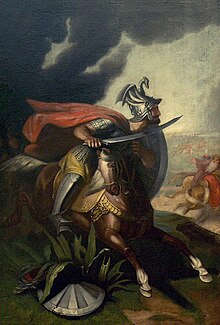มีโลช โอบิลิช
มีโลช โอบิลิช | |
|---|---|
 ภาพวาดโดยอะเล็กซานดาร์ ดอบริช, ค.ศ. 1861 | |
| เกิด | ไม่ทราบ |
| เสียชีวิต | 28 มิถุนายน ค.ศ. 1389 ทุ่งคอซอวอ อำเภอบรันโกวิช |
| อาชีพ | อัศวิน |
| มีชื่อเสียงจาก | การลอบสังหารสุลต่านมูรัดที่ 1 |
มีโลช โอบิลิช (ซีริลลิกเซอร์เบีย: Милош Обилић, ออกเสียง: [mîloʃ ôbilit͡ɕ]) เป็นอัศวินเซอร์เบียในตำนานที่มีชื่อเสียงจากการรับใช้เจ้าชายลาซาร์ในช่วงการรุกรานเซอร์เบียของออตโตมันในช่วงปลายคริสต์ศตวรรษที่ 14 เขาไม่ได้รับการกล่าวถึงในเอกสารร่วมสมัย แต่ปรากฏอย่างเด่นชัดในยุคหลังผ่านบันทึกยุทธการที่คอซอวอเมื่อ ค.ศ. 1389 ในฐานะผู้ลอบสังหารสุลต่านมูรัด[1] แม้ว่าชื่อผู้ลอบสังหารยังไม่ปรากฏในข้อมูลจนกระทั่งปลายคริสต์ศตวรรษที่ 15 การเผยแพร่เรื่องราวการลอบสังหารมูรัดในข้อมูลฟลอเรนซ์ เซอร์เบีย ออตโตมัน และกรีก เสนอแนะว่าเรื่องราวดังกล่าวแพร่กระจายอย่างกว้างขวางทั่วคาบสมุทรบอลข่านหลังจากเหตุการณ์นั้นภายในครึ่งศตวรรษ
แม้ว่าชื่อต้นฉบับคือมีโลช โคบิลิช (Miloš Kobilić) ชื่อของเขาในรูปแบบต่าง ๆ ปรากฏในข้อมูลประวัติศาสตร์หลายแห่ง และไม่เป็นที่กระจ่างว่าเขามีตัวตนจริงหรือไม่ แต่ตระกูลลาซาร์ที่เสริมสร้างการควบคุมทางการเมืองของตน "ให้กำเนิดเรื่องปรัมปราคอซอวอ" ซึ่งรวมถึงเรื่องราวโอบิลิช[2] เขากลายเป็นบุคคลสำคัญในมหากาพย์เซอร์เบียที่เขาได้รับการเลื่อนขั้นถึงระดับวีรบุรุษแห่งชาติผู้สูงศักดิ์ที่สุดในคติชนเซอร์เบียสมัยกลาง การกระทำของมีโลชกลายเป็นส่วนสำคัญของประเพณีเซอร์เบียที่เกี่ยวกับยุทธการที่คอซอวอ ร่วมกับการพลีชีพของเจ้าชายลาซาร์และข้อกล่าวหาการทรยศของวูก บรันโกวิช (Vuk Branković) ในคริสต์ศตวรรษที่ 19 มีโลชได้รับการยกย่องเป็นนักบุญในคริสตจักรเซอร์เบีย
มีโลชยังเป็นที่จดจำในมหากาพย์แอลเบเนียจากคอซอวอภายใต้ชื่อ Millosh Kopiliqi และกล่าวกันว่าบ้านเกิดของเขาอยู่ในภูมิภาคเดรนิตซาที่มีหมู่บ้านชื่อ Kopiliq ตั้งอยู่[3][4]
อ้างอิง[แก้]
- ↑ "Battle of Kosovo | Summary". Encyclopedia Britannica (ภาษาอังกฤษ). สืบค้นเมื่อ 2021-06-16.
- ↑ Judah (2009). The Serbs. Yale University Press. p. 32. ISBN 978-0-300-15826-7.
- ↑ Schwartz, Stefan (2000). Kosovo: Background to a War. Anthem Press. p. 38. ISBN 978-1898855569.
The tale told to us by Berisha corresponds to an Albanian - language Kosovo ballad recorded by the folklorist G. Elezović in the 1920s and later commented upon anew by Lord . Indeed, Lord treats the tale of Murat and Milos Kobilić as a mainly Albanian folk expression, tracing its major elements to Albanian oral traditions and noting their absence from the canon elaborated by the famous Serb linguist Vuk Stefanović Karadžić. Lord argues that two traditions, Slav and Albanian, developed independently but then borrowed from each other, meeting in the Sandžak region. Cultural influences went in both directions with the story of the old woman and her advice to the Turks being considered by Lord as essentially Albanian but appearing as far north as eastern Croatia. Lord argued persuasively that this folk image emerged from ancient Albanian lore associated with the land and the origins of rivers.
- ↑ Di Lellio 2013, p. 155:Kopiliq is believed to hail from a village by the same name in Drenica, a central and rural area of Kosovo, famous for its rebelliousness. He plays the role, together with historical characters from the same region, of establishing an uninterrupted genealogy of heroes through history.
ข้อมูล[แก้]
- Di Lellio, Anna (2013). "The field of the blackbirds and the battle for Europe". ใน Langenbacher, Eric; Niven, Bill; Wittlinger, Ruth (บ.ก.). Dynamics of Memory and Identity in Contemporary Europe. Berghahn Books. pp. 149–165. ISBN 978-0-85745-577-2.
- บุคคลที่เสียชีวิตในปี พ.ศ. 1932
- อัศวินชาวเซิร์บ
- ผู้ลอบสังหารสมัยกลาง
- ตัวละครในมหากาพย์เซอร์เบีย
- ตัวละครในมหากาพย์แอลเบเนีย
- ชาวคริสต์นิกายอีสเทิร์นออร์ทอดอกซ์จากประเทศเซอร์เบีย
- ผู้ที่นับถือคริสตจักรออร์ทอดอกซ์เซอร์เบีย
- การลอบสังหารประมุขแห่งรัฐ
- การปลงพระชนม์พระมหากษัตริย์
- วีรบุรุษในปรัมปราวิทยาและตำนาน
- ประวัติศาสตร์คอซอวอ
- บุคคลที่ไม่ทราบปีเกิด
- เรื่องปรัมปรา
- ตำนานชาวเซิร์บ
- บทความเกี่ยวกับ ชีวประวัติ ที่ยังไม่สมบูรณ์
